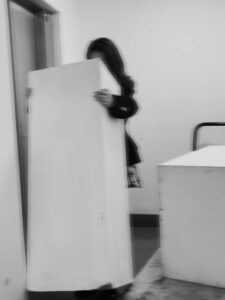It was my first experience approaching and curating an art exhibition. There is no doubt that both the planning and the installation work were quite difficult for me. My exhibition of contemporary art was held at the ECA’s Fire Engine Station. As a new curator, I was experimenting with the entire process, from framing the artwork to placing them up for the first time. I was perplexed by the installation procedures.
Curatorial installation is an important part of an art exhibition and its purpose is to present the curator’s themes and ideas through the way the artwork is arranged and displayed in the space. To begin, we must display a great number of artworks in a small exhibition space. Since Fire Engine Station has seven curators, there are seven different themes of contemporary art displayed in the area. Each curator has a unique topic and method of presenting their work. As a result, how to exhibit our artworks as fully as possible in the restricted area given becomes critical. My artworks, for example, are interconnected with my curatorial endeavours. As a curator, I must guarantee that the artworks are completely shown while highlighting the curatorial theme’s sense of storytelling. This complicates my installation process. I need to think about how I can best use the space to present the works. Curatorial installations must also consider the viewer’s perspective and sentiments. The artwork should be displayed and arranged in a way that corresponds to the audience’s viewing habits and psychological needs in order for them to better understand and appreciate the artwork.
Secondly, the curatorial installation must consider the exhibition venue’s traits and limits. The size, form, and structure of the exhibition location will influence the curatorial installation, and we must make acceptable alterations and arrangements based on the real scenario. These issues necessitate excellent spatial awareness, creative thought, and execution, as well as comprehensive consideration of the audience’s, the artist’s, and the venue’s needs and limits. I had difficulty arranging the artworks due to my lack of experience. Hanging artworks on the board, in particular, is a difficult task. Hanging artworks incorrectly can have a significant impact on the exhibition’s perception. JL is our teacher, although I believe she is more of a curator. JL has been a huge assistance to me with my curatorial efforts, and her sincerity and dedication to her work is something that I am continually reminded of. I am very grateful to her.
Finally, exhibition equipment can be rented. It wasn’t easy for me as well, (PIC.1) as I had to relocate plinths and borrow display screens, etc. I found it challenging to carry the plinths by myself, because they were enormous in size. However, my peers were gracious enough to assist me, and we worked together to complete the equipment rental. I appreciate them very much. It reminded me that our exhibition is a collaborative effort by everyone, not just one individual. It provided me with some food for thought. Wasn’t the curatorial endeavour for “25 Cats” a group effort involving all 25 of us from start to finish? We all worked as a team on the preparation, planning, production, promotion, and eventually the show. We collaborated, brainstormed ideas, and came up with a fresh and inventive contemporary art exhibition.

(PIC.1)
Contemporary art exhibition requires a significant amount of effort to install and de-install. Not only does it necessitate a strong physical presence, but also adequate and competent curatorial understanding. As a result, in order to become a qualified curator, one must learn and improve. A curator, in my opinion, is someone who conveys a tale to the audience. Every curation is a re-creation of a work of art. The installation and de-install works have also provided me with an entirely new perspective on the role of a curator.


Leave a Reply